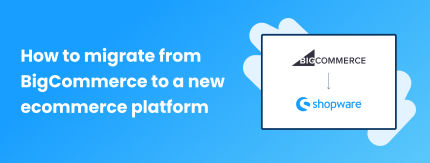
In 2009, BigCommerce was founded in Australia and soon after an office was opened in Austin, Texas. BigCommerce is an ecommerce platform that provides software as a service (SaaS) services to retailers. The company’s platform includes online store creation, search engine optimization, hosting, and marketing and security from small to enterprise sized businesses. However, not all customers of BigCommerce stay with the company and many are migrating away from it.
Reasons for leaving BigCommerce may include:
SaaS may not be best solution for business
Performance issues
Cost
Lack of functionality
A BigCommerce migration can be a daunting task, and pose challenges to your current design and theme, your customers, and your data. However, there are many viable BigCommerce alternatives. This guide will go in-depth and look at all the different aspects you should be considering before you start to migrate.
Pre-migration checklist: What to consider for a migration
Re-platforming
Managing risk
Migration steps: How to move your shop to a new ecommerce platform
Planning
Pre-migration
Platform selection
Data migration
Configuration
Testing
Launch
Selecting the right platform: BigCommerce alternatives to consider
Shopware
WooCommerce
Shopify
OpenCart
Summary
BigCommerce Migration Checklist
Pre-migration checklist: What to consider for a migration
It’s essential that you have all your ducks in-a-row before you start to migrate, preparing for your migration will bring you a much smoother transition. Here’s what to consider when you're planning your ecommerce platform migration.
Re-platforming
Re-platforming poses a risk: you should only embark on this journey if your business case requires it.
Properly scope your project – take time to plan what your migration will look like, and gain a clear understanding of the risks involved.
Core business systems are most important – prioritize your business and its’ operations before worrying about your online platform and sales channels.
Managing risk
Data migration and building integrations will be your biggest areas of risk.
Data migration
How do you get all of your data from your old ecommerce platform (BigCommerce) to your new one? Migrating data includes all of the following:
Products: This includes the products basic data as well as how the products are bundled and configured.
Passwords: It’s tough to import your customers passwords to a new platform, this leads to them having to create new ones, thus creating a conversion barrier.
Saved information: Take time to understand what will happen with your existing customers saved personal information from your old platform.
Orders: All of the underlying entities that make up an order must be transferred to avoid problems.
You know your products best, therefore, data migration will require a great deal of work on your end; as well as extensive collaboration between you and the agency carrying out the data migration.
Integrations
Integrations pose a risk in migration. The complexity of these integrations and their importance to a smooth migration make them ever so important. Payment systems, order management platforms, CRM tools, etc. will all require integration and because these functions are so vital to running your business, it poses substantial risk if something were to go wrong.
Once again, it’s crucial to take time to extensively plan out all the factors of your BigCommerce migration:
Review your current BigCommerce site, and plan your next site
Identify all customizations and extensions
Determine your required data migration
Set up an efficient development environment
Being patient, taking your time, and doing your due diligence will help mitigate any big risks and set your online business up for success.

ARMEDANGELS migrated to Shopware and increased its revenue by 10%. Read the full case study here.
Migration steps: How to move your shop to a new ecommerce platform
So what does BigCommerce migration truly look like from start to finish? Below, we’ve listed 7 different phases that will be essential to a successful migration.
Planning
Planning your migration is one of the most crucial aspects of your migration. Having a thought out plan of attack will reduce the chance you run into surprises down the road. During the planning phase you’ll layout aspects such as:
Goals
Timeline
Resources
Personnel roles and responsibilities
Pre-migration
The pre-migration phase is essentially an audit of your current ecommerce platform. Identify any issues that you’re currently facing and how they will be addressed during migration; you’ll also want to evaluate your current data, themes, layout, and integrations.
Platform selection
Choose the best ecommerce platform for your circumstances. Choose your platform based on your specific business needs, functions, and budget; don’t get caught up in flashy ecommerce trends if they’re not the right fit for your business.
Data migration
Data migration is essential to a seamless platform transition. During this phase you’ll be migrating all of your customers data including their passwords and saved personal information. Other key data being moved will be:
Orders
Catalogs
Products
Currencies
Configuration
Configuring your new platform includes payment methods, shipping options, and overall platform design customization. Customize your platform to your specific business specifications that were laid out in the planning and pre-migration phases.
Testing
Put your new platform through rigorous testing to expose any bugs or flaws that need fixing before you launch your new platform. Test your site’s performance and functionality under different conditions across all types of devices and browsers.
Launch
After testing has been completed and you’ve worked out all necessary kinks in the site, it’s time to go live with your new ecommerce platform. After going live it’s imperative you continue to closely monitor your site's performance and functionality to ensure all aspects are behaving how you expected. If you’re running into issues after launch you should swiftly identify the problem and implement updates accordingly.
Selecting the right platform: BigCommerce alternatives to consider
You’re looking to migrate away from BigCommerce, where will you migrate to? Quite frankly, there is no one size fits all approach––it’s going to depend on your business and your specific needs. Here are a few great BigCommerce alternatives to consider.
Shopware
Shopware is an open source platform that offers 100% visibility into your code. Offering a range of features like multi-lingual support; Shopware is particularly popular with those migrating from BigCommerce, Magento (both 1 and 2) because of its robust Magento migration tool.
WooCommerce
WooCommerce is a free, open source platform built on WordPress. WooCommerce offers a wide range of extensions and plug-ins to its users. The problem many run into with WooCommerce is the fact that it’s built on WordPress; if your site is not built on WordPress- this isn’t the choice for you.
Shopify
Shopify is one of the most popular ecommerce platforms on the market, another SaaS platform, this is a great option for those just starting out. Shopify lets you start selling quickly and offers free-of-charge customer support.
OpenCart
OpenCart is a free and open source platform offering multi-lingual support for international markets. With many similarities to BigCommerce and Magento, the migration from Magento to OpenCart can be less painful than some other platforms.
Summary
In this guide we tackled a wide range of aspects that pertain to ecommerce platform migration. Undoubtedly, migration is an enormous task; it’s important to understand the risks and challenges presented when you’re migrating your ecommerce platform. Take it slow and be patient, this is not a task that should be rushed. Identifying your business needs, and platform specifications during the planning and pre-migration phases will set you up for success the rest of the way.
Shopware has successfully guided more than 2,000 businesses through ecommerce platform migration, and we’d love to help you along your journey. If you’d like to learn more about Shopware, contact us today or request a personal product demo and get to know us inside and out.
BigCommerce migration checklist
We know each business case will be different, however, here’s a checklist to give you a general path to follow during your ecommerce platform migration.
Establish that re-platforming is a necessity in your business case
Identify all risks involved
Extensively plan in a way that mitigates these risks to the best of your ability
Do your research and decide which platform best fits your needs
Migrate your data
Configure your platform
Thoroughly test your new platform
Take the platform live
Continuously monitor your platform and upgrade it as needed
FAQ - BigCommerce migration
Why should I migrate off of BigCommerce to a new platform?
There are several reasons why ecommerce businesses may choose to migrate off of BigCommerce to a new platform, including a focus on SaaS, outdated technology, poor site performance, lack of customization options, and rising costs of ownership. A new platform may provide better features and functionality that can better support your business needs and growth goals.
How do I choose a new platform for my ecommerce business?
Choosing a new platform for your ecommerce business requires careful consideration of your business needs, budget, and goals. Look for platforms that offer robust features, strong security, and flexibility for customization. It is also important to evaluate the platform's user-friendliness and support options.
What data will I need to migrate to the new platform?
You will need to migrate all relevant data from your BigCommerce site, including product catalogs, customer information, order histories, and other data. It is important to ensure that all data is transferred accurately and securely during the migration process.
What is the most suitable Magento 1 and Magento 2 alternative?
For most ecommerce businesses generating more than $1m annually, Shopware is considered the best Magento 1 and Magento 2 alternative. It is an open-source platform that offers many robust features and customization options.
What are the best open-source alternatives to BigCommerce?
The best BigCommerce alternatives in open-source software are Shopware, WooCommerce, Shopify, and OpenCart. However, in most comparisons, Shopware is selected as the overall best alternative to BigCommerce.
Can I keep my existing design and theme during the migration?
It may be possible to keep your existing design and theme during the migration, depending on the new platform you choose. However, it is also an opportunity to update and refresh your design to take advantage of the latest design trends and functionality available in the new platform.
What is the timeline for a BigCommerce migration to a new platform?
The timeline for a BigCommerce migration to a new platform can vary depending on the size and complexity of the site being migrated, as well as the amount of customization required. Typically, a migration can take anywhere from a few weeks to several months to complete.
Do I need a developer to perform the migration?
While it is possible to perform a platform migration on your own, it is recommended to work with an experienced developer who has expertise in ecommerce migrations. This can help ensure that the migration is performed correctly and that any issues or challenges that arise during the process can be addressed quickly and effectively.










